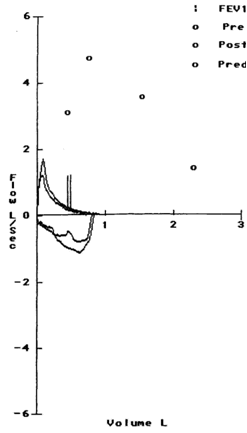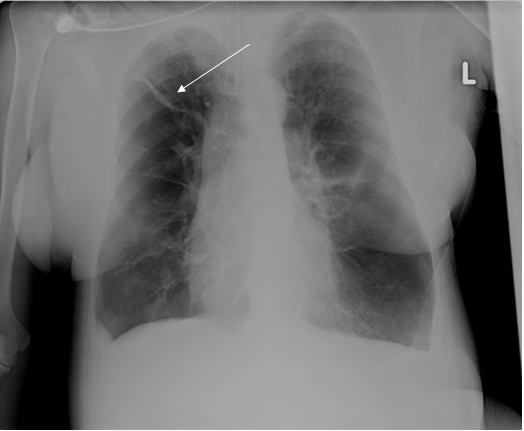
Pulmonary Function Testing
Case 5 Answer
A 41 year-old woman presents to the General Internal Medicine Clinic at Harborview Medical Center complaining of dyspnea with mild exertion. She has a 10 pack-year history of smoking and a history of using intravenous drugs including heroin and ritalin.
Her pulmonary function testing is as follows:
| Pre-Bronchodilator (BD) | Post- BD | ||||
|---|---|---|---|---|---|
| Test | Actual | Predicted | % Predicted | Actual | % Change |
| FVC (L) | 0.90 | 3.09 | 29 | 0.74 | - 17 |
| FEV1 (L) | 0.49 | 2.57 | 19 | 0.44 | -10 |
| FEV1/FVC (%) | 54 | 83 | 59 | 8 | |
| RV (L) | 3.83 | 1.49 | 257 | ||
| TLC (L) | 4.78 | 4.44 | 108 | ||
| RV/TLC (%) | 80 | 33 | |||
| DLCO* corr | 0.75 | 24.85 | 3 | ||
| *DLCO is measured in ml/min/mmHg | |||||
| Check abbreviations>> | |||||
His flow volume loops is as follows:

Case 5 Interpretation
This patient has evidence of air-flow obstruction, as her FEV1, FVC and her FEV1/FVC are all decreased. Her flow volume demonstrates the characteristic scooped-out appearance seen in obstructive lung disease and also demonstrates markedly reduced peak expiratory flows. Based on her FEV1 of 19% predicted this would be classified as “very severe” obstructive lung disease. The patient also has evidence of air-trapping, as her RV is 257% predicted. She would not be classified as being hyper-inflated because her TLC is only 108% predicted. There is no evidence of a bronchodilator response as her FVC and FEV1 both decline following bronchodilator administration. Her DLCO is also decreased, indicating a loss of alveolar-capillary surface area for gas exchange.
It is highly unlikely for a 41 year-old person to have obstructive lung disease with only a 10-pack year history of smoking. Asthma is an unlikely diagnosis given the absence of reversibility with bronchodilator administration. Her chest x-ray provides some clues to the diagnosis, however. There is marked hyper-lucency at the bases, suggesting that this is a basilar-predominant form of emphysema. The minor fissure (arrow) is also shifted upward on the right side, indicating that the lower lobes are over-inflated. Two disorders can give you early-onset emphysema with a basilar predominance: alpha-one anti-trypsin deficiency (it is usually only seen this early if the person also smokes) and ritalin lung. The latter is an uncommon form of the severe basilar-predominant emphysema seen in people who previously used intravenous injections of ritalin (methylphenidate).

UW School of Medicine : School of Medicine Mission
Copyright and Disclaimer : Credits and Acknowledgements